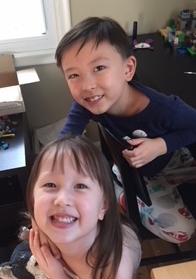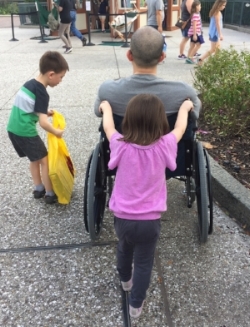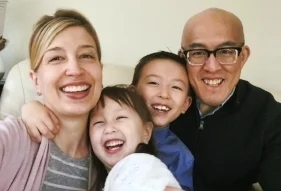By Laura Harley
Note from Bill and Jean: One of our daughters, Laura Harley, is sharing a guest post here today. Laura has her own life coaching practice and helps her clients practice the concepts in our books. This post is one in a series in which Laura shares examples of how her young family uses Compassionate Consultation (which is the subject of our second book, TRANSFORMED) to solve problems and make decisions. We know many families are striving to do the same and hope examples like this are useful!
In my last posts, I described a time our family of four used the process of Compassionate Consultation (CC) together, as well as a time I used CC with both of my children. Today I’m sharing an example in which my 7-year-old son, Daniel, and I used CC.
Here’s the backstory. We homeschool our children and Daniel and I have been struggling with some of his morning lessons. He much prefers child-led, interest-based learning and we make time for a lot of that in our homeschool. But I also feel the need to make sure core subjects are covered, and so we do need some more structured lesson time each day. Our challenge has been that lately Daniel feels impatient and negative when we do our more structured lessons and this makes me feel impatient, too. We both really wanted to find a solution to our challenge, and so I told him I’d like to use CC with him.
As all parents know, life with kids can be busy and chaotic and this morning was no exception. One of the challenges with using CC in a family is finding the time and space to do it in a focused way. This particular morning, I saw that my 4-year-old daughter was occupied with a game that generally holds her attention for 10-15 minutes, so I took the opportunity to talk with my son. We were going somewhere later that morning, and I hadn’t had a chance to brush my teeth or comb my hair, so I asked him to come with me to the bathroom while I did those things. Ideally, I would have liked to sit down with him in a more focused way to use CC, but I’ve learned that if I keep putting it off until I find a peaceful time to do it, it almost never happens! So, we’ve been trying to use CC even amidst the chaos.
OK, so back to the process. As a review, below is one of the CC models our family has been practicing that is introduced in the book, TRANSFORMED. The model is not rigid; and we often use the steps out of order and sometimes don’t complete the whole process in one sitting. We do what we can, when we can.
6-Step Model of Compassionate Consultation (get a free printable of these steps here)
1. Pray for divine guidance
2. Identify and agree on the facts*
3. Identify and agree on the issue*
4. Identify and agree on the spiritual principles involved
5. Identify and agree on the solutions
6. Identify and agree on the implementation steps
*Steps 2 and 3 may be reversed as needed
Note: For more information about this and other CC models, examples of how to use them, the CC behavioral standards and much more, read TRANSFORMED: How to Make the Decisions That Change Your Life.
In this instance I said something like, “Daniel, you know how we’ve been struggling with our structured morning lessons? You’ve not been enjoying it and then I become impatient and it’s kind of miserable for both of us?” Of course he knew just what I was talking about. I asked him to use CC with me about this to see if we could come up with some ideas to make it better. He really liked that I wanted to work with him on this. Kids often feel honored when their parents ask them to collaborate to find solutions and they are eager to work together (that is, if the parent genuinely wants to work together and hear their ideas!).
I suggested we start by praying for assistance together and recited short prayer. When I was finished, Daniel spontaneously said the prayer, too. It was really sweet!
Then I jumped to step 4, identifying and agreeing on the spiritual principles involved. I find that when consulting with kids, going to this step early on can be really helpful. Children tend to be truly in touch with the essence and heart of things, so they can connect really well with this step. This step is also very helpful for me as a parent. Because I’m often trying to attend to many things at once, and because the many details of the day can put me in a state of “just get things done and attend to everyone”, identifying the spiritual principles involved dilates my heart, slows me down, and gets me focused on what is most important.
Next I said, “So what are some of the spiritual principles involved here? Hmmm…..I’m thinking here of joy---that we’d both like to feel joyful when we are together and when we are learning. What do you think?” He agreed and was quiet for a couple moments. Then I said, “I also think patience is important here. I want to be more patient with you and I want to support you in learning how to be patient with the things we need to do.” He nodded. I asked, “What are any other ideas?” He said, “Kindness! I want to be kind to you and I want you to be kind to me.” Well, as you can imagine, this brought tears to my eyes. He had captured the essence of our challenge so beautifully and powerfully! Could anything be more important than us being kind to each other? I thanked him and agreed wholeheartedly. Then we hugged ☺
Then I said, “Ok, so what are some of the facts involved here? For example, we know we have to get certain lessons done each day. And we know you haven’t been loving how that’s been going.” He agreed. I asked him, “What are some other facts?” And when that question didn’t lead to ideas from him, I asked another question to encourage his ideas. I asked, “When you think about this situation, what do you want to have happen?” He said, “I just want more time to work on my other projects. I always feel like I’m not getting to them.” I asked, “So when we are working on structured lessons, are you kind of counting down the time until you can get to those other things?” He said, “Yes! Always!” It seemed like a relief to him to understand that and to share that with me. I acknowledged that and said that must feel frustrating for him. I also talked with him about state requirements for homeschools and showed him the records I need to keep on what we work on, so that he could understand why I was asking him to do certain lessons. We also talked about how important learning a range of things is.
Since we had talked about a lot of facts at that point, it felt like it was time to move to the “identify and agree on solutions” step. You may notice I skipped over the “identify and agree on the issue” step. This was partially because it felt like we both understood the issue pretty well and also because I knew our time would be quite limited as my daughter was starting to show signs of wanting my attention.
So I said, “OK, so given these facts and spiritual principles we’ve agreed upon, what are any ideas we have about how to make things better?” To be honest, I felt a little worried at this point since I wasn’t sure what to do to make things better and I didn’t think he knew what to do either. But this is where I reminded myself to trust the process. The Baha'i Writings (the source material for CC), encourage us to use Consultation in all things, not just those things that we as parents already have ideas on how to solve!
We thought in silence for a few minutes and then I had an idea. I said, “Would it help if you knew exactly what we need to get through each time so you have a better idea of when we’ll be done?” He said, “Maybe, but I am not sure what you mean”. So I showed him how I could make a checklist of the things we need to learn each day so he could feel more in control of his time. He liked this idea, but neither of us was sure how much of a difference it would actually make in practice.
At this point, my daughter needed my attention and I could see we needed to wrap up. So I thanked him for talking with me and said I was so glad we talked. I told him I felt like I understood much better how he was feeling. He was happy we talked and we both felt closer. I suggested we keep trying various solutions and checking in to see how things were working (or not working). He agreed and happily skipped off to play. He seemed to feel lighter already!
Since then, we tried the checklist which helped. And a few days later, while thinking about our Compassionate Consultation together and doing some research, I came across a different kind of homeschooling approach that seemed like it might be a better fit for Daniel’s interests and learning style. In effect, I discovered some new facts which could turn into a new solution. We tested the new approach by starting to use it; and so far it is working well. I feel that discovering this was directly linked to the steps Daniel and I took in our CC process. The prayers for divine assistance we said in Step 1 and the interpenetration of our ideas in subsequent steps resulted in confirmations both during and after the CC process.
Some of my key learnings from this experience include:
- It is ok to use CC even when the time doesn’t seem “ideal” to do so. Even when we are in a hurry, even when I feel worried about how it will go, even when we feel stuck during the process at times, CC is still effective. Even if we can’t finish the process in one sitting or aren’t able to come up with a solution right then, the process creates such a respectful connection that we build greater love and understanding between us and “set the stage” for the next time we come together to work through challenges.
- Using CC with children is powerful. Our Consultations together help Daniel feel that I truly care about his ideas and that our relationship is important to me. And that (more than any solution we find) is what is most important for our learning and our family.
- Using CC helps everyone focus on what is most important, which makes navigating challenges much easier, more meaningful, and more unifying.
I hope this example of how CC can look is useful. We’d love to hear how the process is working for you and your family. We welcome your questions and stories! Feel free to comment below.
For more examples of CC applications with couples, families and other groups, read TRANSFORMED: How to Make the Decisions That Change Your Life






















